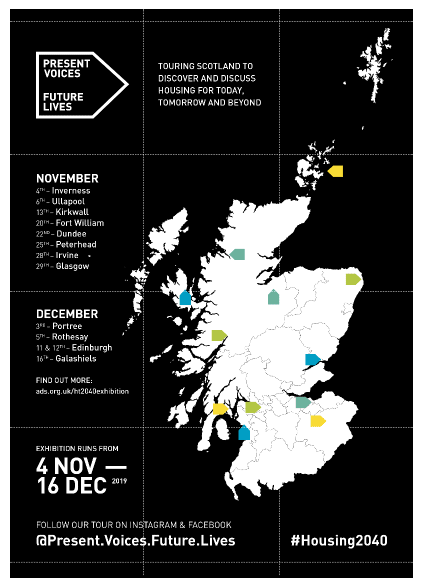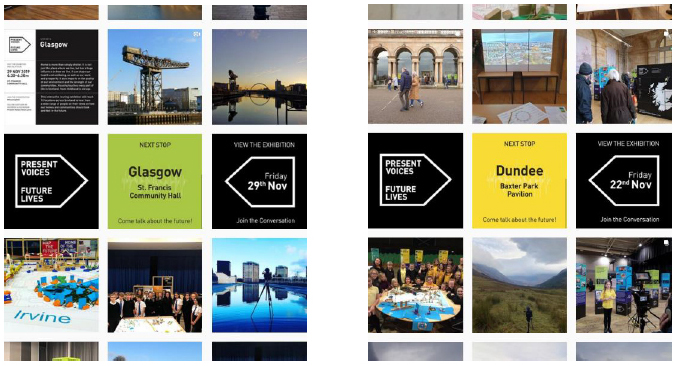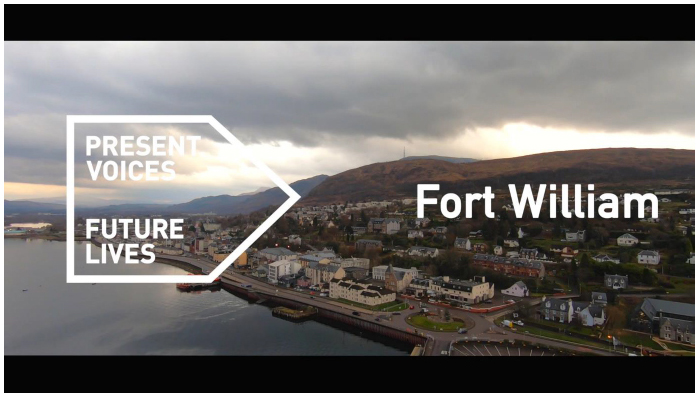Housing to 2040 - Present Voices, Future Lives: final report
A final report summarising and describing the responses gathered from children, young people and communities on Housing to 2040 as part of the travelling housing exhibition 'Present Voices, Future Lives' that toured twelve rural, urban and island locations across Scotland in 2019.
This document is part of a collection
4. Touring 'Present Voices Future Lives'
4.1 Locations
The locations were selected to represent the diversity of communities in Scotland. Twelve places were chosen to represent cities, towns, rural and islands, in order to explore priorities and challenges in each location across a range of different settings / contexts. It was important to include a good breadth of places from urban to rural and from city to islands to capture the range of views and priorities relative to housing across Scotland.
Identification of places to locate the exhibition were driven by a number of factors. Each category of city, town, rural and island needed to be represented and it was agreed that three within each category would be selected. The size, location and character of the places were discussed to ensure that coverage of issues was achieved and that the sample would be representative enough of the wider population. See Appendix 7.2 for more detail on each location.

Figure description:
Figure 9 presents a map of the exhibition tour. The following 12 locations with exhibition dates are marked on the map: Glasgow, Edinburg, Dundee, Inverness, Kirkwall, Portree, Rothesay, Peterhead, Irvine, Fort William, Ullapool and Galashiels.
In subsequent analysis there is a small change to the places in each category. Fort William is defined as Rural and Galashiels is defined as a Town. This decision was based on two factors: proximity to other settlements, and population size. This is explained in full in section 5.3.
4.2 Programme
The exhibition aimed to provide an opportunity for communities to engage with the development of the Housing to 2040 vision and route map. The programme was based on visiting twelve venues during autumn and winter of 2019. Public sessions initially programmed for 6-8 pm were started earlier (4.30-6.30 pm) to encourage community members to attend directly after work. Inclement weather and dark evenings were thought to be resulting in low attendance at the evening opening.
| Date | Location | Exhibition and Workshop Venue | Public Opening times |
|---|---|---|---|
| 4 November | Inverness | Inverness Royal Academy | 18:00-20:00 |
| 6 November | Ullapool | Ullapool High School | 18:00-20:00 |
| 13 November | Kirkwall | Kirkwall & St. Ola Town Hall | 18:00-20:00 |
| 20 November | Fort William | The Nevis Centre | 14:30-16:30 |
| 2 November | Dundee | Baxter Park Pavilion | 18:00-20:00 |
| 25 November | Peterhead | Peterhead Academy | 16.30-18.30 |
| 28 November | Irvine | Irvine Royal Academy | 16.30-18.30 |
| 29 November | Glasgow | St. Francis Community Hall | 16.30-18.30 |
| 3 December | Portree | Portree High School | 16.30-18.30 |
| 5 December | Rothesay | Rothesay Joint Campus | 16.30-18.30 |
| 11-12 December | Edinburgh | Castlebrae Community High School | 16.30-18.30 |
| 16 December | Galashiels | Galashiels Academy | 16.30-18.30 |
4.3 Engaging with Schools and Communities
'Present Voices Future Lives' aimed to engage young people in the workshops, as the adults of 2040. In each location we contacted a secondary school serving a large population in the area. In nine locations we had groups of young people from 11 to 17 years old (Secondary 1 to Secondary 5) taking part in workshops. In the other three locations we had: one Primary 6 group; one University student group; and a mixed age early year's activity club respectively. In the secondary schools we had groups participating from a wide range of subject areas: modern studies; art & design; geography; and some whole year groups.
Where possible we located the exhibition within the school itself. The decision to locate all the engagements within schools and community spaces provided a logistical challenge, and the design team worked closely with schools to establish the exhibition date and audience for each location.
In five locations the exhibition was sited in community venues. Groups of young people came to these venues with their teachers. In schools the exhibition was set up within sports and assembly halls. The community spaces ranged from cathedral spaces to 1970s community halls.
Community members were invited to visit the exhibition through a number of communication channels. This included direct email through Scottish Government and Local Government networks, local advertisements in papers and radio. The schools circulated information about the event to parent and community networks. Social media was used to raise awareness of the exhibition and the progressing of the tour through Scotland.
4.4 Social Media Strategy

Figure description:
Figure 11 presents two screenshots from the ‘Present Voices, Future Lives’ exhibition Instagram account. A range of pictures and graphic designs was used to promote and raise awareness of the exhibition tour, providing details of the exhibition and updates on progress around the country.
The team worked hard with the Scottish Government and A&DS to promote the exhibition to local people, community groups and people working within their communities from the housing, design, construction and planning sectors.
A&DS assisted in setting up a dedicated webpage on their website to publish the exhibition programme, preparing and issuing press releases at significant stages of the exhibition development and promotion.
As part of the continued strategy of promoting the tour, 'Present Voices Future Lives' used Facebook, Instagram and Twitter to share details of the exhibition and updates on progress around the country. These pages were used both to promote forthcoming engagements and to document previously visited locations.
4.5 Filming and Photography - 'Present Voices Future Lives'
Chris Leslie Productions was commissioned to produce the films for the 'Present Voices Future Lives' project. Chris Leslie, working with Craig Stewart (photographer) accompanied the 'Present Voices Future Lives' team to each location on the tour.
In each of the twelve locations an interview was recorded with a member of the local community, or someone who had links to the area. These interviews drew out key issues relating to housing and community in the local area. Filming in each location reflects the landscape and built environment character of the place. The interviews are embedded within the location footage and capture something of the character of the place, the quality of housing and what home means now and into the future. Each film addresses particular concerns (see Section 5.7 for more detail).

Figure description:
This picture captures a screenshot from the ‘Present Voices, Future Lives’ film from Fort William developed by Chris Leslie Productions.
Three minute films were produced for each location, along with one minute long social media edits of each film. They documented in some way the location of the engagement, sometimes incorporating time-lapse and drone footage. In some locations aspects of the exhibition and workshop engagement were also included.
For the final event at the Engine Shed in Stirling an eight minute long compilation film was produced, including short interviews with members of the team. All project films can be viewed at Present Voices Future Lives Films. It is intended that a suitable version of the films will be hosted online by the Scottish Government.
Each person interviewed brought a different perspective and together they give a narrative to the challenges facing housing in Scotland. Participants were identified through local networks and selected to provide a diverse inclusive range of voices across the films. The film maker incorporated questions that were relevant to each location in the interviews, and themes that emerged from the exhibition workshops. This provides a rich tapestry of the issues facing housing and how we live from individual perspectives.
Photographs of the entire project were taken by all members of the team and particularly Glasgow based photographer Craig Stewart. Craig has created a presentation of the project photography titled 'Present Voices Future Lives' Photographic Exhibition.
Many photographs 'on the road' throughout Scotland and at each exhibition and workshop engagement can be viewed on the projects Instagram, Twitter and Facebook pages (see Section 4.4 above).
Contact
Email: Housing2040@gov.scot
There is a problem
Thanks for your feedback